Measurement of Scenic Spots Sustainable Capacity Based on PCA-Entropy TOPSIS: A Case Study from 30 Provinces, China
Abstract
:1. Introduction
2. Literature Review
2.1. Research on the Development of Scenic Spots
2.2. Summary on Previous Research
3. Summary of Sustainable Capacity Measurement Mode
3.1. Measurement Model
3.2. Principal Components Analysis
- (1)
- Data standardization. This paper relies on the raw data of measurement index of each province and city to establish the initial measurement matrix . In order to eliminate the difference of selected indexes in the quantity and size, collected raw data of indexes need to be standardized to obtain the standardized matrix ;
- (2)
- Computing related coefficient matrix ;
- (3)
- According to the characteristic equation , computing that characteristic value is and characteristic vector is ;
- (4)
- Computing principal component contribution rate and accumulated contribution rate :
- (5)
- Computing principal component loading :
- (6)
- Computing the score of each principal component:
3.3. Entropy Method Based TOPSIS Analysis
3.3.1. Determination of Entropy of Principal Component Factor
3.3.2. Determination of Approach Degree by TOPSIS Method
4. Establishment of Measurement Index System of Sustainable Development
5. Empirical Study
5.1. Optimization of Measurement Index System by PCA
5.1.1. Determination of Quantity of Principal Components
5.1.2. Determination of Standardized Principal Component Coefficient
5.2. Entropy TOPSIS Based Measurement of Sustainable Capacity of Scenic Spots
Computation of Principal Component Decision Matrix and Entropy of Each Principal Component
6. Results Analysis
6.1. Analysis of Sustainable Development of Scenic Spots of Chinese Provinces and Cities
6.2. Analysis of Sustainable Capacity of Scenic Spots by Areas
7. Suggested Countermeasures
- For the western and northeastern regions where the sustainable development levels of all aspects of scenic areas are relatively low, the following two measures are proposed:
- (1)
- Local governments need to increase financial support, improve the scenic area software support to the scenic area function of scientific planning and positioning, give full play to the advantages of scenic resources, create a distinctive tourism brand, improve the attraction and competitiveness of scenic areas, promote the development of the scenic area economy from the policy and technological innovation, and then lead the development of auxiliary industries around the scenic area;
- (2)
- Developing scenic resources reasonably and paying attention to the protection and management of ecological environment for protecting the future tourism development depends on the existence of environmental quality, improving the scenic area management mode for getting rid of extensive development and management mode of scenic area;
- (3)
- Improving the basic public facilities and entertainment services around the scenic area, reasonably planning the network of scenic traffic, better the quality of life in the tourist reception area for providing tourists with high quality tourism experience.
- For the central region where the scale and benefit of the auxiliary industry of scenic spots are not outstanding, it is necessary to excavate the characteristics of its own tourism resources, differentiate and accurately locate the market, and provide high-quality tourism services; Strengthening the cooperation of regional tourism and the comprehensive integration of tourism resources, commonly designing and developing the routes of cross regional tourism, the construction of tourism fine lines and the establishment of barrier-free tourism mechanism, promoting the free flow of industrial factors for accelerating the integration process of regional tourism development.
- For the eastern region with good scenic resources and ecological management, it is necessary to promote the optimization and upgrading of tourism industrial structure and the accelerated development of tourism economy on the premise of protecting the existing ecological environment. Deepening the reform and innovation of the management system and related policies, constructing a number of tourist pioneer areas and demonstration areas for promoting the development of the central, western and northeastern regions in China, cultivating new growth point of tourism economy innovatively.
8. Conclusions
- (1)
- After giving comprehensive consideration to the resource condition, economic benefit, auxiliary industrial scale, auxiliary industry benefit and ecological environment in relation to the sustainable capacity of scenic spots, this model establishes a relatively comprehensive sustainable capacity evaluation index system to provide relatively reliable reference to the objective multiple-objective measurement;
- (2)
- Utilizing the principal component analysis and entropy TOPSIS method, this model establishes the sustainable capacity measurement model of scenic spots. Firstly, while decreasing the computation quantity effectively by principal components analysis, this model reduces the multi-dimensional index influencing the sustainable development of scenic spots to the lower dimensional index; secondly, through assigning the objective weight to the lower dimensional index by entropy method, this model avoids the subjective influence brought by the personal preference to make the result more objective and scientific; finally, this model further lowers the weighted low dimensional index to one dimensional index by TOPSIS method to analyze the sustainable development of scenic spots of each province and city in an easier manner. Therefore, this measurement model is better adapted to the sustainable development of scenic spots that it may ensure the scientific and reasonable result while decreasing the workload;
- (3)
- Study on the measurement of the sustainable development of scenic spots is very significant for understanding the sustainable development of scenic spots and their auxiliary industries to establish specific and scientific countermeasures;
Acknowledgments
Author Contributions
Conflicts of Interest
References
- World Tourism Organization (WTO). Guide for Local Authorities on Developing Sustainable Tourism; WTO: Madrid, Spain, 1998. [Google Scholar]
- Jin, Q.; Hu, H.; Kavan, P. Factors Influencing Perceived Crowding of Tourists and Sustainable Tourism Destination Management. Sustainability 2016, 8, 976. [Google Scholar] [CrossRef]
- Yao, L.F.; Ma, R.M.; Liao, Z.X.; Du, S.Y.; Jin, M.Z.; Ren, P.Y. Optimization and simulation of tourist shunt scheme: A case of Jiuzhai Valley. Chaos Solitons Fractals 2016, 89, 455–464. [Google Scholar] [CrossRef]
- Duan, Z.P.; Li, R.R.; Ma, H.F. An Engineering Pricing Model for Scenic Spots Based on Revenue Management. Syst. Eng. Procedia 2011, 1, 279–285. [Google Scholar]
- Iniesta-Bonillo, M.A.; Sánchez-Fernández, R.; Jiménez-Castillo, D. Sustainability, value, and satisfaction: Model testing and cross-validation in tourist destinations. J. Bus. Res. 2016, 69, 5002–5007. [Google Scholar] [CrossRef]
- Liao, Z.; Jin, M.Z.; Ren, P.Y.; Luo, Y.Y. Research on scenic spot’s sustainable development based on a SD model: A case study of the Jiuzhai valley. Sustainability 2014, 6, 4632–4644. [Google Scholar] [CrossRef]
- Cucculelli, M.; Goffi, G. Does sustainability enhance tourism destination competitiveness? Evidence from Italian Destinations of Excellence. J. Clean. Prod. 2016, 111, 370–382. [Google Scholar] [CrossRef]
- Mónica, G.M.; Tomás, G.N.; Silvia, A.D. A combined ANP-delphi approach to evaluate sustainable tourism. Environ. Impact Assess. Rev. 2012, 34, 41–50. [Google Scholar]
- García-Rosell, J.C.; Mäkinen, J. An integrative framework for sustainability evaluation in tourism: Applying the framework to tourism product development in Finnish Lapland. J. Sustain. Tour. 2013, 21, 394–416. [Google Scholar] [CrossRef]
- Xu, J.; Wei, J.C.; Zhao, D.T. Influence of social media on operational efficiency of national scenic spots in china based on three-stage DEA model. Int. J. Inf. Manag. 2016, 36, 374–388. [Google Scholar] [CrossRef]
- Begum, H.; Er, A.C.; Alam, A.S.A.F.; Sahazali, N. Tourist’s Perceptions towards the Role of Stakeholders in Sustainable Tourism. Procedia Soc. Behav. Sci. 2014, 144, 313–321. [Google Scholar] [CrossRef]
- Garrod, B.; Fyall, A. Beyond the Rhetoric of Sustainable Tourism? Tour. Manag. 1998, 19, 199–212. [Google Scholar] [CrossRef]
- Gössling, S.; Hansson, C.B.; Hörstmeier, O.; Saggel, S. Ecological footprint analysis as a tool to assess tourism sustainability. Ecol. Econ. 2002, 43, 199–211. [Google Scholar] [CrossRef]
- Lee, T.H.; Hsieh, H.P. Indicators of sustainable tourism: A case study from a Taiwan’s wetland. Ecol. Indic. 2016, 67, 779–783. [Google Scholar] [CrossRef]
- Zhang, M. Evaluation of sustainable development of tourist attractions based on AHP. Stat. Decis. 2013, 16, 52–54. [Google Scholar]
- Othman, J. Assessing scenic beauty of nature-based landscapes of Fraser’s Hill. Procedia Environ. Sci. 2015, 30, 115–120. [Google Scholar] [CrossRef]
- Chen, C.M.; Lin, Y.L.; Hsu, C.L. Does air pollution drive away tourists? A case study of the Sun Moon Lake National Scenic Area, Taiwan. Transp. Res. Part D 2017, 53, 398–402. [Google Scholar] [CrossRef]
- Ding, J.J.; Zhu, Q.H. Study on Spatial-temporal Differences of Development Potential of Regional Tourism Industry in China. Tour. Trib. 2012, 27, 52–61. [Google Scholar]
- Wu, L.M.; Huang, Z.F.; Zhou, W.; Fang, Y.L. The Spatiotemporal Evolution and Dynamic Mechanism of A-Grade Tourist Attractions in Jiangsu Province. Econ. Geogr. 2013, 33, 158–164. [Google Scholar]
- He, G.; Hu, Y.M. Evaluation on sustainable development of scenic rural tourism. Chin. J. Agric. Resour. Reg. Plan. 2012, 33, 85–90. [Google Scholar]
- Li, H.Q.; Hou, L.C. Evaluation on Sustainable Development of Scenic Zone Based on Tourism Ecological Footprint: Case Study of Yellow Crane Tower in Hubei Province, China. Energy Procedia 2011, 5, 145–151. [Google Scholar] [CrossRef]
- Li, F.; Wan, N.Q.; Shi, B.L.; Liu, X.M.; Guo, Z.J. The vulnerability measure of tourism industry based on the perspective of “environment-structure” integration: A case study of 31 provinces in mainland China. Geogr. Res. 2014, 33, 569–581. [Google Scholar]
- Zheng, Q.C.; Kuang, Y.Q.; Huang, N.S. Coordinated Development between Urban Tourism Economy and Transport in the Pearl River Delta, China. Sustainability 2016, 8, 1338. [Google Scholar] [CrossRef]
- Hwang, C.L.; Yoon, K. Multiple Attribute Decision Making; Springer: Berlin/Heidelberg, Germany, 1981. [Google Scholar]
- Ding, L.; Shao, Z.F.; Zhang, H.C.; Xu, C.; Wu, D.W. A Comprehensive Evaluation of Urban Sustainable Development in China Based on the TOPSIS-Entropy Method. Sustainability 2016, 8, 746. [Google Scholar] [CrossRef]
- Lozano-Oyola, M.; Blancas, F.J.; González, M.; Caballero, R. Sustainable tourism indicators as planning tools in cultural destinations. Ecol. Indic. 2012, 18, 659–675. [Google Scholar] [CrossRef]
- Tudorache, D.M.; Simon, D.; Frent, C.; Mărioara, M.P. Difficulties and Challenges in Applying the European Tourism Indicators System (ETIS) for Sustainable Tourist Destinations: The Case of Braşov County in the Romanian Carpathians. Sustainability 2017, 9, 1879. [Google Scholar] [CrossRef]
- Zhong, Y.; Liu, W. Economic Features of Modern Service Cluster and Their Implications. Trop. Geogr. 2012, 32, 568–574. [Google Scholar]
- He, H. Analysis and Forecast of Coupling Coordination Development among the Tourism Industry -Regional Economy-Ecological Environment in Hanzhong. J. Anhui Agric. Sci. 2017, 45, 165–170. [Google Scholar]
- Hu, Z.P.; Huang, X.X.; Fu, C.; Yu, D.J. The Quantitative Comparison and Evolutionary Analysis on Interactive Coupling among Tourism, Urbanization and Ecological Environment in Poyang Lake Area. Resour. Environ. Yangtze Basin 2015, 24, 2012–2020. [Google Scholar]
- Zhou, C.; Feng, X.G.; Tang, R. Analysis and Forecast of Coupling Coordination Development among the Regional Economy-Ecological Environment-Tourism Industry—A Case Study of Provinces along the Yangtze Economic Zone. Econ. Geogr. 2016, 36, 186–193. [Google Scholar]
- Li, Y.Z.; Xu, K.; Wang, K. Analysis of Tourism-Economy-Environment Coupling and Coordination in Shandong Province. Areal Res. Dev. 2016, 35, 99–103, 109. [Google Scholar]
- Zhou, F.X. Evaluation of Sustainable Utilization of Ecotourism Resources: A Case Study of Hunan Province. Stat. Decis. 2014, 9, 68–71. [Google Scholar]
- Zhou, Z.H. The Evaluation on Tourism Sustainable Development in Changsha-Zhuzhou-Xiangtan Urban Agglomeration. Chin. Agric. Sci. Bull. 2012, 28, 140–145. [Google Scholar]
- Zhang, G.H.; Liu, Z.Z.; Wang, X.Y. Analysis and forecast of coupling degree between tourism-oriented development and eco-environment in coastal region of China. Ecol. Environ. Sci. 2013, 22, 792–800. [Google Scholar]
- Fu, Y.X.; Hu, B.; Wang, Y. Research on Spatial-temporal Evolution of Tourism Competitiveness in 31 Provinces of China. Econ. Geogr. 2012, 32, 144–149. [Google Scholar]
- Du, Y. The Measurement and Evaluation of the Tourism Industry Development Potential-As an Example of Hunan Province. Econ. Geogr. 2014, 34, 176–181. [Google Scholar]
- National Tourism Administration of the People’s Republic of China. The Yearbook of Tourism Statistics; China Tourism Press: Beijing, China, 2016. [Google Scholar]
- State Statistics Bureau. China Statistical Yearbook; China Statistics Press: Beijing, China, 2016. [Google Scholar]
- State Statistics Bureau. China Statistical Yearbook on Environment; China Statistics Press: Beijing, China, 2016. [Google Scholar]
- Jenks, G.F.; Caspall, F.C. Vertical Exaggeration in Three-Dimensional Mapping; Technical Report 2; University of Kansas: Manhattan, KS, USA, 1967. [Google Scholar]
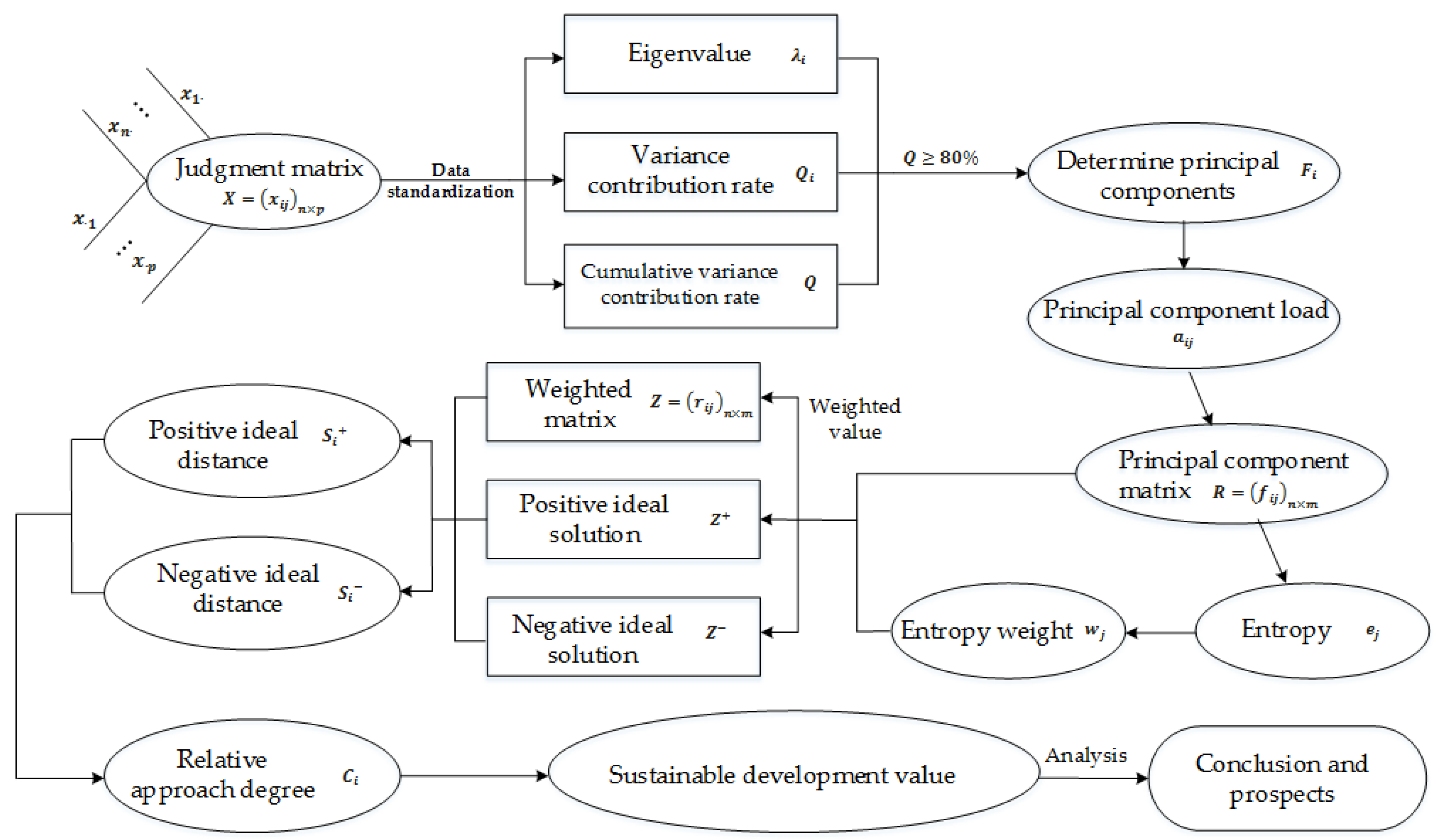
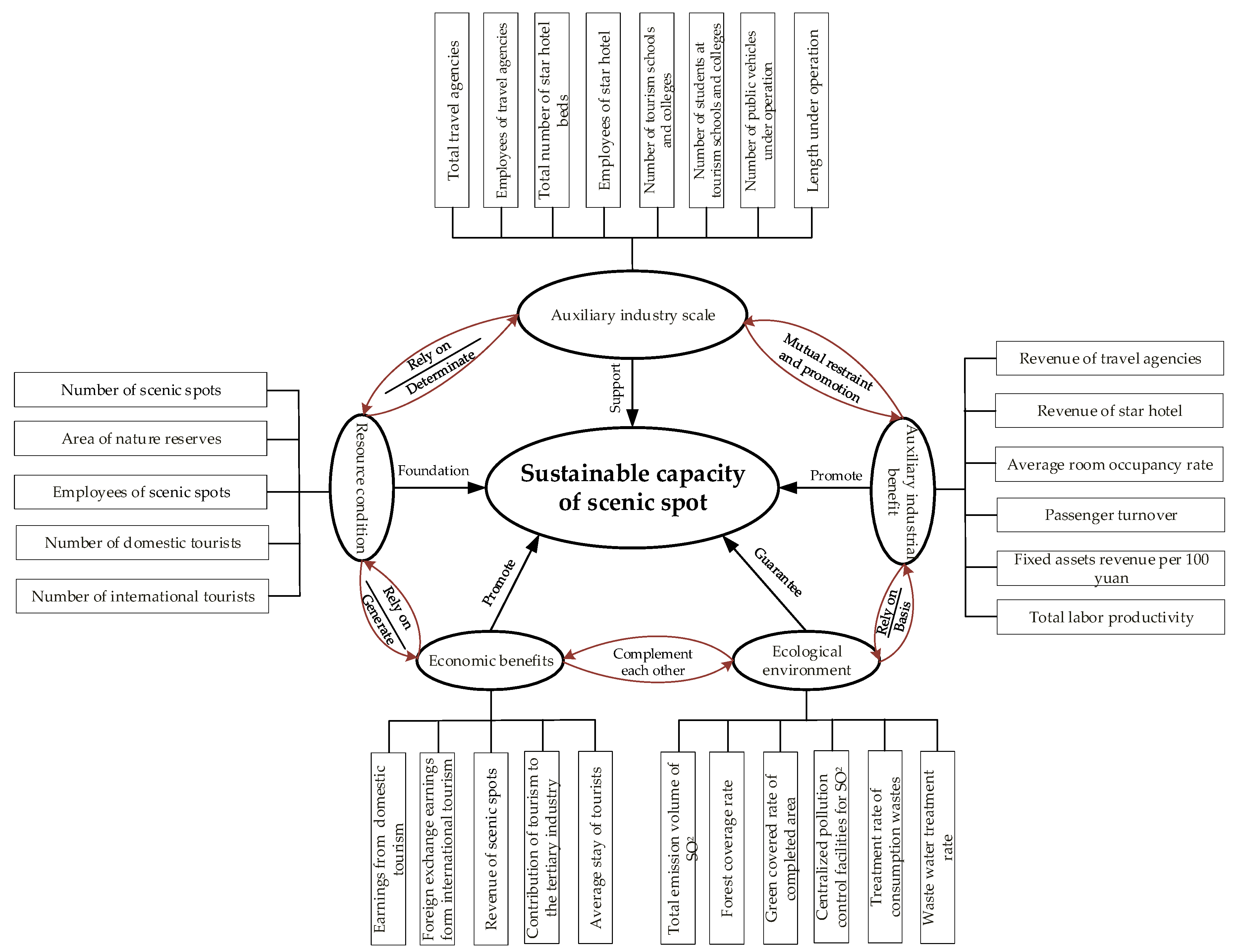
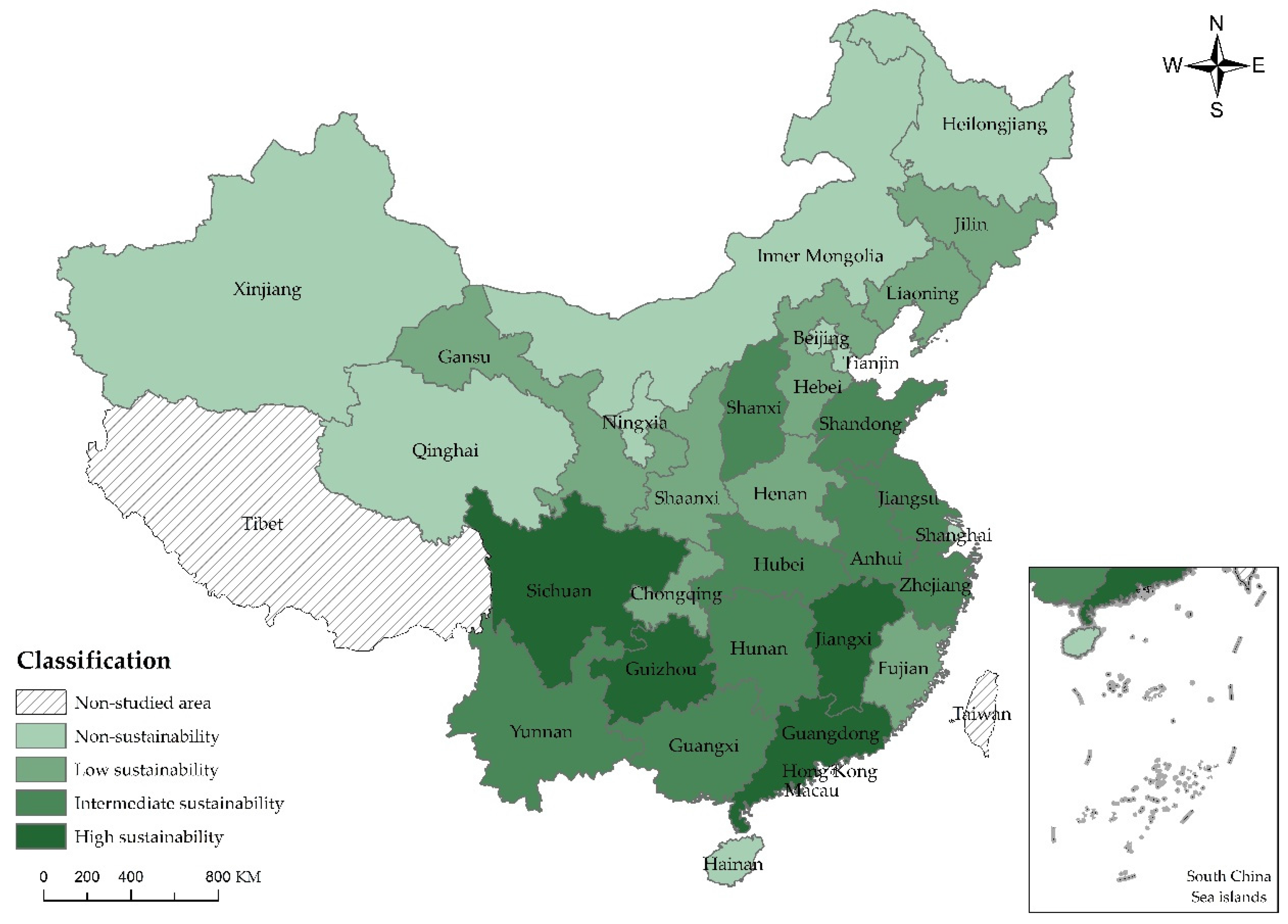
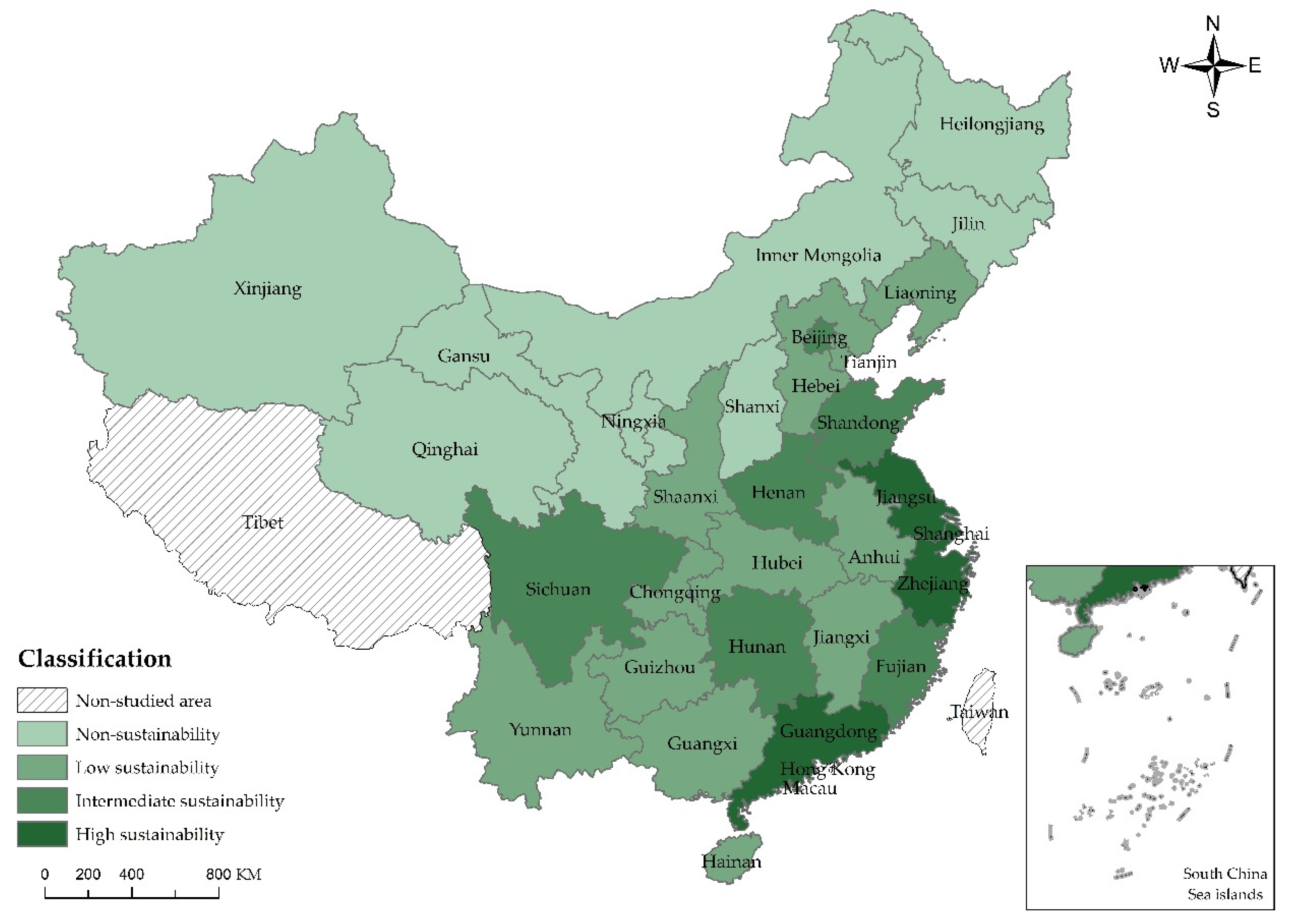
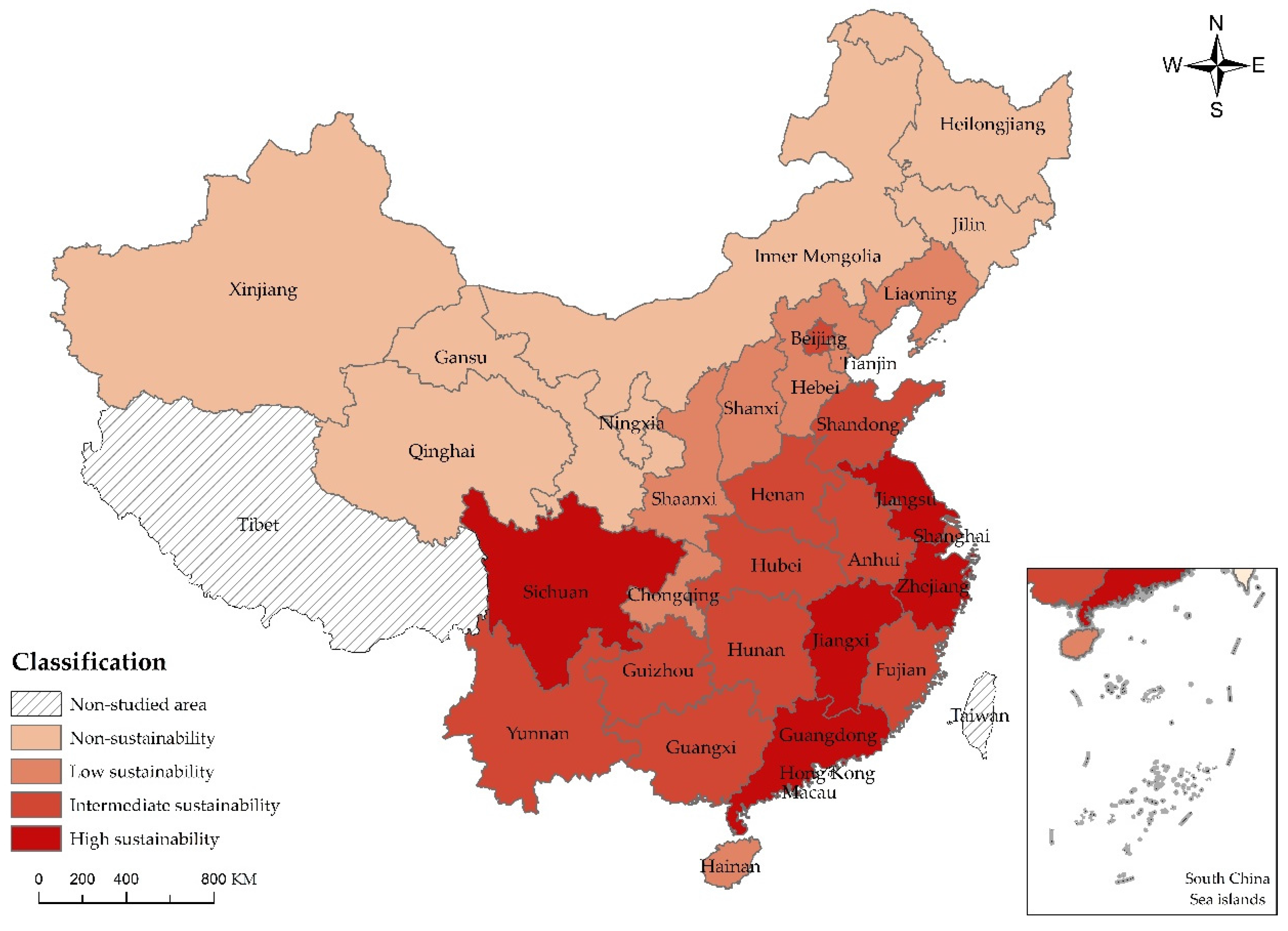
| Category | Primary Index | Secondary Index | References |
|---|---|---|---|
| Self-sustainable capacity | Resource condition of scenic spot B1 | Number of scenic spots (units) B11 | [18,30,34,36,37] |
| Area of nature reserves(10,000 hectares) B12 | [31] | ||
| Employees of scenic spots (persons) B13 | [26] *, [31] * | ||
| Number of domestic tourists (100 million person-times) B14 | [15] *, [18], [20] *, [26] *, [29,30,31,32,33,34,35,36,37] | ||
| Number of international tourists (10,000 person-times) B15 | [15] *, [18], [20] *, [26] *, [29,30,31,32,33,34,35,36,37] | ||
| Economic benefits of scenic spot B2 | Earnings from domestic tourism (100 million yuan) B21 | [20,29,30,31,32,34,35,36,37] | |
| Foreign exchange earnings form international tourism (million dollars) B22 | [20,28,29,30,31,32,33,34,35,36,37] | ||
| Revenue of scenic spots (100 million yuan) B23 | [34] * | ||
| Contribution of tourism to the tertiary industry (%) B24 | [15] *, [20] *, [29,30,32] | ||
| Average stay of tourists (days) B25 | [18,27] | ||
| Ecological environment of scenic spot B3 | Total emission volume of SO2 (ton) B31 | [28] *, [29,32] | |
| Forest coverage rate (%) B32 | [15] *, [20,30,34] | ||
| Green covered rate of completed area (%) B33 | [18,28,29] | ||
| Centralized pollution control facilities for SO2 (unit) B34 | [28] * | ||
| Treatment rate of consumption wastes (%) B35 | [20,29,30,31,32,34] | ||
| Waste water treatment rate (%) B36 | [26,29,31,32,34] | ||
| Sustainable capacity of auxiliary industry | Auxiliary industry scale B4 | Total travel agencies (unit) B41 | [18,28,29,31,35,36] |
| Employees of travel agencies (persons) B42 | [26] *, [31] *, [36] | ||
| Total number of star hotel beds (unit) B43 | [18] *, [27] *, [37] | ||
| Employees of star hotel (persons) B44 | [36] | ||
| Number of tourism schools and colleges (schools) B45 | [31] | ||
| Number of students at tourism schools and colleges (persons) B46 | [18,31,35,37] | ||
| Number of public vehicles under operation (unit) B47 | [15] *, [34] * | ||
| Length under operation (km) B48 | [15] *, [34] *, [37] | ||
| Auxiliary industrial benefit B5 | Revenue of travel agencies (100 million yuan) B51 | [31,35,37] | |
| Revenue of star hotel (100 million yuan) B52 | [34] * | ||
| Average room occupancy rate (%) B53 | [34] *, [36] | ||
| Passenger turnover (100 million passenger-km) B54 | [33] | ||
| Fixed assets revenue per 100 yuan (yuan) B55 | [33] | ||
| Total labor productivity (1000 yuan/person) B56 | [18,29] |
| Component | Initial Eigenvalues | Rotation Sums of Squared Loadings | ||||
|---|---|---|---|---|---|---|
| Total | % of Variance | Cumulative % | Total | % of Variance | Cumulative % | |
| 1 | 5.769 | 36.053 | 36.053 | 3.513 | 21.954 | 21.954 |
| 2 | 2.321 | 14.505 | 50.558 | 3.274 | 20.463 | 42.417 |
| 3 | 1.95 | 12.186 | 62.744 | 2.491 | 15.568 | 57.985 |
| 4 | 1.727 | 10.795 | 73.539 | 2.016 | 12.601 | 70.586 |
| 5 | 1.071 | 6.692 | 80.231 | 1.543 | 9.646 | 80.231 |
| 6 | 0.99 | 6.185 | 86.416 | |||
| L | L | L | L | |||
| 15 | 0.035 | 0.22 | 99.809 | |||
| 16 | 0.031 | 0.191 | 100 | |||
| Component | Initial Eigenvalues | Rotation Sums of Squared Loadings | ||||
|---|---|---|---|---|---|---|
| Total | % of Variance | Cumulative % | Total | % of Variance | Cumulative % | |
| 1 | 8.607 | 61.478 | 61.478 | 5.287 | 37.761 | 37.761 |
| 2 | 2.522 | 18.011 | 79.489 | 5.078 | 36.271 | 74.033 |
| 3 | 1.208 | 8.629 | 88.118 | 1.972 | 14.085 | 88.118 |
| 4 | 0.501 | 3.581 | 91.699 | |||
| L | L | L | L | |||
| 13 | 0.015 | 0.108 | 99.956 | |||
| 14 | 0.006 | 0.044 | 100 | |||
| Index | Self-Sustainable Capacity | Sustainable Capacity of Auxiliary Industry | ||||||
|---|---|---|---|---|---|---|---|---|
| 1 | 2 | 3 | 4 | 5 | 1 | 2 | 3 | |
| B11 | −0.079 | 0.324 | −0.018 | 0.035 | −0.184 | |||
| B12 | 0.062 | 0.09 | −0.352 | −0.144 | 0.023 | |||
| B13 | 0.053 | 0.196 | −0.063 | 0.097 | −0.088 | |||
| B14 | 0.078 | 0.14 | 0.015 | 0.015 | 0.111 | |||
| B15 | 0.347 | −0.11 | −0.119 | −0.033 | 0.053 | |||
| B21 | 0.155 | 0.099 | 0.01 | −0.017 | 0.046 | |||
| B22 | 0.315 | −0.126 | −0.005 | 0.025 | −0.072 | |||
| B23 | −0.014 | 0.108 | −0.038 | −0.025 | 0.346 | |||
| B24 | −0.016 | −0.088 | −0.001 | −0.151 | 0.7 | |||
| B25 | 0.018 | −0.088 | 0.311 | −0.392 | −0.025 | |||
| B31 | 0.106 | −0.327 | 0.051 | 0.15 | −0.051 | |||
| B32 | 0.069 | −0.186 | 0.014 | 0.361 | 0.133 | |||
| B33 | −0.027 | −0.057 | 0.399 | −0.073 | −0.026 | |||
| B34 | 0.246 | 0.056 | −0.03 | −0.115 | −0.03 | |||
| B35 | −0.113 | 0.038 | 0.119 | 0.463 | −0.282 | |||
| B36 | −0.087 | 0.092 | 0.277 | −0.076 | 0.038 | |||
| B41 | 0.879 | −0.151 | −0.155 | |||||
| B42 | 0.933 | 0.19 | −0.198 | |||||
| B43 | 0.902 | −0.091 | −0.136 | |||||
| B44 | 0.95 | −0.042 | −0.068 | |||||
| B45 | 0.758 | −0.456 | 0.286 | |||||
| B46 | 0.788 | −0.423 | 0.273 | |||||
| B47 | 0.933 | −0.188 | −0.12 | |||||
| B48 | 0.885 | −0.251 | −0.155 | |||||
| B51 | 0.786 | 0.518 | −0.202 | |||||
| B52 | 0.891 | 0.383 | −0.174 | |||||
| B53 | 0.587 | 0.463 | 0.531 | |||||
| B54 | 0.617 | −0.599 | 0.336 | |||||
| B55 | 0.238 | 0.565 | 0.673 | |||||
| B56 | 0.453 | 0.812 | −0.086 | |||||
| F1 | F2 | F3 | F4 | F5 | F6 | F7 | F8 | |
|---|---|---|---|---|---|---|---|---|
| 0.102 | 0.107 | 0.062 | 0.079 | 0.167 | 0.153 | 0.167 | 0.163 | |
| Beijing | 0.307 | −0.921 | 0.535 | 0.325 | −0.775 | 3.059 | −1.230 | 0.345 |
| Tianjin | 0.387 | −1.527 | 2.748 | −3.427 | −0.250 | −0.352 | −0.995 | 0.498 |
| Hebei | −0.567 | 0.865 | 0.070 | −0.299 | −0.375 | −0.123 | 0.404 | −1.414 |
| Shanxi | −0.663 | 0.111 | 0.352 | −0.510 | 0.945 | −0.182 | −0.578 | −1.248 |
| Inner Mongolia | −0.817 | 0.531 | −0.318 | −0.514 | −0.602 | −0.021 | −0.763 | −1.381 |
| Liaoning | −0.027 | 0.625 | 0.053 | 0.240 | −0.406 | 0.296 | 0.150 | −1.134 |
| Jilin | −0.534 | −0.817 | 0.324 | 0.450 | 0.082 | −0.268 | −0.673 | −0.984 |
| Heilongjiang | −0.523 | −0.101 | −0.762 | 0.876 | −1.212 | −0.256 | −0.535 | −0.751 |
| Shanghai | 0.120 | −0.860 | 0.470 | 0.340 | −1.311 | 2.139 | −1.573 | 2.239 |
| Jiangsu | 0.285 | 1.644 | 0.789 | −0.099 | −0.671 | 0.725 | 1.530 | 0.903 |
| Zhejiang | 0.899 | 0.246 | 0.407 | 0.939 | −0.039 | 1.394 | 0.979 | 0.095 |
| Anhui | −0.389 | 0.544 | 0.661 | 0.253 | 0.646 | −0.591 | 0.652 | −0.164 |
| Fujian | 0.169 | −1.149 | 0.725 | 1.299 | −0.458 | −0.126 | −0.068 | 1.848 |
| Jiangxi | −0.334 | −0.045 | 0.394 | 0.526 | 2.565 | −0.746 | −0.044 | 0.678 |
| Shandong | 0.164 | 3.273 | 0.422 | −0.174 | −1.190 | 0.869 | 1.358 | −0.662 |
| Henan | −0.443 | 0.930 | 0.088 | −0.138 | −0.070 | −1.235 | 1.360 | 0.577 |
| Hubei | −0.165 | 0.231 | 0.027 | 0.263 | 0.264 | −0.524 | 0.786 | 0.150 |
| Hunan | −0.139 | 0.675 | 0.099 | 1.277 | −0.256 | −0.808 | 0.885 | 1.341 |
| Guangdong | 4.862 | −0.117 | −0.420 | −0.057 | 0.170 | 2.168 | 2.330 | −1.183 |
| Guangxi | −0.038 | −0.575 | 0.008 | 0.861 | 0.639 | −0.831 | 0.338 | 0.303 |
| Hainan | −0.328 | −1.742 | −0.534 | 1.470 | −0.710 | −0.254 | −1.166 | 0.949 |
| Chongqing | −0.434 | −0.419 | 0.768 | 0.372 | −0.304 | −0.642 | 0.008 | 0.945 |
| Sichuan | 0.384 | 0.991 | −0.637 | −0.023 | 1.460 | −0.654 | 0.891 | 0.519 |
| Guizhou | −0.572 | −0.264 | −0.105 | −0.191 | 2.564 | −0.988 | −0.220 | 0.753 |
| Yunnan | 0.129 | −0.430 | −0.333 | 0.209 | 1.222 | −0.365 | 0.584 | −0.672 |
| Shaanxi | −0.403 | −0.033 | 0.454 | 0.419 | 0.191 | −0.374 | −0.026 | 0.307 |
| Gansu | −0.242 | −0.084 | −1.911 | −1.823 | 0.554 | −0.521 | −0.725 | −0.262 |
| Qinghai | 0.019 | −0.952 | −3.237 | −0.693 | −0.728 | −0.422 | −1.389 | −0.675 |
| Ningxia | −0.703 | −0.861 | 0.255 | −0.290 | −1.402 | −0.131 | −1.483 | −1.663 |
| Xinjiang | −0.402 | 0.234 | −1.394 | −1.881 | −0.543 | −0.236 | −0.786 | −0.258 |
| 0.496 | 0.350 | 0.170 | 0.116 | 0.429 | 0.467 | 0.390 | 0.365 | |
| −0.083 | −0.186 | −0.200 | −0.270 | −0.235 | −0.189 | −0.263 | −0.271 |
| Region | Self-Sustainable Capacity of Scenic Spot | Sustainable Capacity of Auxiliary Industry | Sustainable Capacity of Scenic Spot | |||
|---|---|---|---|---|---|---|
| Value | Rank | Value | Rank | Value | Rank | |
| Beijing | 0.324 | 22 | 0.523 | 5 | 0.435 | 10 |
| Tianjin | 0.322 | 23 | 0.324 | 21 | 0.323 | 23 |
| Hebei | 0.360 | 18 | 0.310 | 22 | 0.337 | 21 |
| Shanxi | 0.423 | 9 | 0.212 | 26 | 0.338 | 20 |
| Inner Mongolia | 0.315 | 24 | 0.204 | 28 | 0.269 | 27 |
| Liaoning | 0.376 | 16 | 0.327 | 20 | 0.354 | 19 |
| Jilin | 0.357 | 19 | 0.212 | 27 | 0.299 | 24 |
| Heilongjiang | 0.306 | 26 | 0.243 | 25 | 0.281 | 26 |
| Shanghai | 0.298 | 27 | 0.550 | 4 | 0.442 | 9 |
| Jiangsu | 0.416 | 11 | 0.625 | 1 | 0.509 | 2 |
| Zhejiang | 0.440 | 8 | 0.572 | 3 | 0.501 | 3 |
| Anhui | 0.444 | 6 | 0.382 | 14 | 0.416 | 13 |
| Fujian | 0.364 | 17 | 0.505 | 6 | 0.433 | 11 |
| Jiangxi | 0.545 | 2 | 0.383 | 13 | 0.479 | 5 |
| Shandong | 0.442 | 7 | 0.503 | 7 | 0.467 | 6 |
| Henan | 0.390 | 15 | 0.457 | 9 | 0.426 | 12 |
| Hubei | 0.402 | 13 | 0.421 | 11 | 0.411 | 14 |
| Hunan | 0.412 | 12 | 0.495 | 8 | 0.454 | 8 |
| Guangdong | 0.555 | 1 | 0.594 | 2 | 0.576 | 1 |
| Guangxi | 0.421 | 10 | 0.378 | 15 | 0.401 | 16 |
| Hainan | 0.315 | 25 | 0.363 | 18 | 0.337 | 22 |
| Chongqing | 0.352 | 20 | 0.415 | 12 | 0.382 | 18 |
| Sichuan | 0.521 | 3 | 0.449 | 10 | 0.486 | 4 |
| Guizhou | 0.516 | 4 | 0.366 | 17 | 0.454 | 7 |
| Yunnan | 0.454 | 5 | 0.353 | 19 | 0.408 | 15 |
| Shaanxi | 0.393 | 14 | 0.373 | 16 | 0.384 | 17 |
| Gansu | 0.333 | 21 | 0.254 | 24 | 0.297 | 25 |
| Qinghai | 0.220 | 30 | 0.178 | 29 | 0.202 | 30 |
| Ningxia | 0.254 | 29 | 0.142 | 30 | 0.210 | 29 |
| Xinjiang | 0.256 | 28 | 0.268 | 23 | 0.262 | 28 |
| Rank | Range | Classification | Explanation |
|---|---|---|---|
| Level 1 | >0.4537 | High sustainability | Scenic resources development scientific planning, high degree of governance for ecological environment, scenic auxiliary industry development is highly mature |
| Level 2 | 0.3926–0.4536 | Intermediate sustainability | Scenic resources development is reasonable, the effective management of ecological environment, scenic auxiliary industry reached a certain scale but the benefits are not outstanding |
| Level 3 | 0.3239–0.3925 | Low sustainability | The pattern of scenic resources development needs to be improved, the attention of ecological management is not enough, the scale and benefit of scenic auxiliary industry are not significant |
| Level 4 | 0–0.3238 | Non-sustainability (unacceptable) | The exploitation of scenic resources is extremely unreasonable, the pollution of ecological environment is serious, the auxiliary industry is not large and the benefit is low |
| Region | Self-Sustainable Capacity of Scenic Spot | Sustainable Capacity of Auxiliary Industry | Sustainable Capacity of Scenic Spot | |||
|---|---|---|---|---|---|---|
| Value | Rank | Value | Rank | Value | Rank | |
| East | 0.608 | 1 | 0.933 | 1 | 0.712 | 1 |
| Central | 0.558 | 2 | 0.331 | 2 | 0.446 | 2 |
| West | 0.344 | 4 | 0.044 | 4 | 0.253 | 4 |
| Northeast | 0.422 | 3 | 0.307 | 3 | 0.366 | 3 |
| National average | 0.483 | - | 0.404 | - | 0.444 | - |
© 2017 by the authors. Licensee MDPI, Basel, Switzerland. This article is an open access article distributed under the terms and conditions of the Creative Commons Attribution (CC BY) license (http://creativecommons.org/licenses/by/4.0/).
Share and Cite
Liang, X.; Liu, C.; Li, Z. Measurement of Scenic Spots Sustainable Capacity Based on PCA-Entropy TOPSIS: A Case Study from 30 Provinces, China. Int. J. Environ. Res. Public Health 2018, 15, 10. https://doi.org/10.3390/ijerph15010010
Liang X, Liu C, Li Z. Measurement of Scenic Spots Sustainable Capacity Based on PCA-Entropy TOPSIS: A Case Study from 30 Provinces, China. International Journal of Environmental Research and Public Health. 2018; 15(1):10. https://doi.org/10.3390/ijerph15010010
Chicago/Turabian StyleLiang, Xuedong, Canmian Liu, and Zhi Li. 2018. "Measurement of Scenic Spots Sustainable Capacity Based on PCA-Entropy TOPSIS: A Case Study from 30 Provinces, China" International Journal of Environmental Research and Public Health 15, no. 1: 10. https://doi.org/10.3390/ijerph15010010
APA StyleLiang, X., Liu, C., & Li, Z. (2018). Measurement of Scenic Spots Sustainable Capacity Based on PCA-Entropy TOPSIS: A Case Study from 30 Provinces, China. International Journal of Environmental Research and Public Health, 15(1), 10. https://doi.org/10.3390/ijerph15010010





